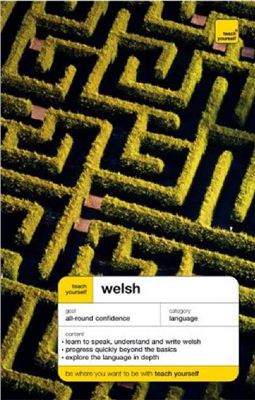Brake J. , Jones Ch. Teach Yourself Welsh Complete Course. -
McGraw-Hill, 2003. - 320 p.
Developing your skills
Our aim is to teach you to understand and speak Welsh as it is spoken today. In order to achieve this, the language introduced here is centred on a wide range of realistic everyday situations. The emphasis is first and foremost on using Welsh, but we also explain how rhe language works, so that you can adapt your knowledge to appropriate situations.
The course covers the four basic skills - listening and speaking, reading and writing. It you are working on your own, rhe recorded material will be particularly important, as it will provide you with the essential opportunity to listen to Welsh spoken by native speakers and to speak the language within a controlled framework. If you do not have the recorded material you should try to obtain it.
Structure of this course
The course book contains 21 units, which are preceded by an alphabet and pronunciation guide, a mutation chart for quick reference and a map of Wales. Four progress tests, a glossary of grammatical terms, vocabularies and a more detailed reference section are included in the back of rhe book. Recordings and a comprehensive Welsh dictionary are available separately.
Each course unit contains most or all of the following:
Statement of aims
At the beginning of each unit there is a list of what you should be able to do in Welsh on completion of that unit.
Presentation of new language
This is usually in the form of dialogues, on the recording and in the book or in reading passages. Assistance with vocabulary is also given. You will find all the words listed in the back of the book. The language is presented in manageable chunks, building carefully on what you have leat in earlier units.
Practice of new language
Practice is graded so that exercises which require mainly recognition come first. As you lea more and grow in confidence, you will be encouraged to write and speak the language yourself.
Description of language forms
In these sections you will lea about the forms of the language, so that you are able to construct your own sentences correctly. For those who are daunted by grammar, assistance is given in a variety of ways, especially by means of the points to notice sections. All grammatical terms are defined within the relevant units.
Information sections
Here you will find information on various aspects of Welsh life and culture - from the history of David, the sixth-century patron saint of Wales, to the establishment of the National Assembly for Wales in 1999.
The reference section contains:
four progress tests
a short description of regional differences
a summary of the forms of 'yes' and 'no'
a key to the exercises
a glossary of grammatical terms
a Welsh-English vocabulary
an English-Welsh vocabulary
a taking it further section
Developing your skills
Our aim is to teach you to understand and speak Welsh as it is spoken today. In order to achieve this, the language introduced here is centred on a wide range of realistic everyday situations. The emphasis is first and foremost on using Welsh, but we also explain how rhe language works, so that you can adapt your knowledge to appropriate situations.
The course covers the four basic skills - listening and speaking, reading and writing. It you are working on your own, rhe recorded material will be particularly important, as it will provide you with the essential opportunity to listen to Welsh spoken by native speakers and to speak the language within a controlled framework. If you do not have the recorded material you should try to obtain it.
Structure of this course
The course book contains 21 units, which are preceded by an alphabet and pronunciation guide, a mutation chart for quick reference and a map of Wales. Four progress tests, a glossary of grammatical terms, vocabularies and a more detailed reference section are included in the back of rhe book. Recordings and a comprehensive Welsh dictionary are available separately.
Each course unit contains most or all of the following:
Statement of aims
At the beginning of each unit there is a list of what you should be able to do in Welsh on completion of that unit.
Presentation of new language
This is usually in the form of dialogues, on the recording and in the book or in reading passages. Assistance with vocabulary is also given. You will find all the words listed in the back of the book. The language is presented in manageable chunks, building carefully on what you have leat in earlier units.
Practice of new language
Practice is graded so that exercises which require mainly recognition come first. As you lea more and grow in confidence, you will be encouraged to write and speak the language yourself.
Description of language forms
In these sections you will lea about the forms of the language, so that you are able to construct your own sentences correctly. For those who are daunted by grammar, assistance is given in a variety of ways, especially by means of the points to notice sections. All grammatical terms are defined within the relevant units.
Information sections
Here you will find information on various aspects of Welsh life and culture - from the history of David, the sixth-century patron saint of Wales, to the establishment of the National Assembly for Wales in 1999.
The reference section contains:
four progress tests
a short description of regional differences
a summary of the forms of 'yes' and 'no'
a key to the exercises
a glossary of grammatical terms
a Welsh-English vocabulary
an English-Welsh vocabulary
a taking it further section

